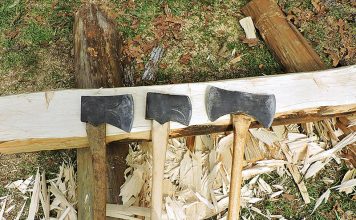| Issue #93 • May/June, 2005 |
My first exposure to a home power system came when I visited the remote homestead of a retired electrical engineer. What a set-up. Housed in its own little building was a diesel generator, a bank of batteries, and a control panel that looked like something designed by NASA. Outside stood a three-legged tower with an elevated platform crowded with solar panels that automatically tracked the sun. When he told me the price tag of his investment I came to two conclusions. First, he had more money than sense. Second, there was no way I’d ever be able to live off grid without reverting to a 19th century lifestyle. Well, I was half right.
That was 10 years ago. I have a lot of respect for those who have the knowledge and cash to set up a classy solar energy system. Our problem is that we are not electrical engineers nor are we financially able to build a system that can compete with the power company. We needed something simpler and cheaper. What we’ve learned is that with careful planning and self-discipline, it is possible to have your electrical needs met without investing thousands of dollars in a home power system. Here’s how we did it.
Step one: reduce demand
When you think of electrical demand on a home power system visualize a 50-gallon barrel of water. Water is running into the barrel at the rate of five-gallons-per-minute. The barrel also has a hose attached to the bottom in which the water is running out at the rate of ten-gallons-per-minute. It doesn’t take a rocket scientist to see that the water is running out twice as fast as it’s going in. Obviously you’re going to run out of water. To avoid that you need to (a) reduce the rate the water flows out, (b) increase the rate the water flows in, (c) put in a larger reservoirwhich won’t stop it from eventually running out, but it will last longer, or (d) some combination of the above.
To apply this to powering your home, think of the energy flowing in and charging your system (solar, wind, or hydro power) as the water flowing into the barrel. The storage system, which would be your batteries, is like the barrel. The amount of electricity you are using is like the water flowing out. Obviously, wind and solar energy outputs fluctuate according to the amount of sunlight or wind you have available so you’re going to need batteries to store the electricity they produce. The more batteries you have, the more electricity you can store. The more or larger solar panels or wind generators you have, the more power you can produce. The problem is that batteries, solar panels, and wind generators are expensive. In addition, you’re going to need an inverter to convert the electricity stored in the batteries from direct current (DC) to alternating current (AC). Good inverters are (like everything else that’s good) expensive, and the larger the inverter, the more it’s going to cost.
|
Cutting back on your electrical needs is the easiest and most economical way to save money when setting up your home power system. By cutting back on your needs you can get by with a smaller inverter, fewer batteries, and fewer or smaller solar panels or wind generators, all of which saves you money.
Take an inventory of everything on your property that uses electricity. List all electrical appliances and tools, from the water heater, the stereo, and television, to the bulb used in the porch light.
List the number of watts the item uses. (This will be found on the tool or appliance.) Some appliances use an amp rating instead of watts. Multiply the amps by the voltage to get the number of watts needed to run the appliance. For example: our vacuum cleaner uses 12 amps. Twelve amps X 120 volts = 1440 watts. The reason you’ll need to know how many watts are required is because generators and inverters are rated in watts rather than amps.
Some things may have two listings. One is the number of watts needed to start the tool or appliance. The other is the number of watts needed to run it once you get it going. Be sure to figure in the higher number. Your power supply must be adequate for the highest figure.
Next, decide if this is an “essential” or “nonessential” item. This is entirely subjective. If mom can’t do without her hair dryer or curling iron then list it as essential. The same goes for dad. If he can’t imagine life without his table saw (or hair dryer?) then it too must be listed as essential.
Some things might be considered essential even if they are seldom used. We kept our waffle iron even though we use it only occasionally.
Estimate how often you use the appliance (daily, weekly, rarely, etc.). Is the appliance “home power friendly?” For example: some televisions, VCRs, DVD players, etc., draw power even when the unit’s power switch is turned off in order to maintain memory, run clocks, or energize “instant-on” circuits. If you have appliances like these you’ll want to be sure that (a) the batteries never go completely dead, or (b) you have an automatic back-up system such as a generator that will kick in if your batteries get low. Of course if you don’t mind the clock flashing the wrong time or waiting a bit longer for the television to come on you can put in a separate switch to completely shut off the power to the unit and end the drain on your batteries. Those multiple outlet power strips work well for this.
|
Overall electrical draw may or may not be a red flag in this category. A microwave may draw a lot of power but only run for a few minutes, whereas a toaster oven with the same watt rating may be in use for 30 minutes or more. Obviously the toaster oven will use a lot more power in the long run.
Are there practical, non-electric alternatives to the appliance? For example: a refrigerator or freezer may not use much electricity per hour but it’s on 24 hours per day, seven days a week. That’s no big deal if you’re on the grid, but when you’re generating your own power it can be a problem. That doesn’t mean you must go without a refrigerator. There are propane and kerosene powered models that work just as well. There are multiple alternatives to electric lights as well, such as propane, kerosene, or gasoline. There are also low-wattage fluorescent lights that work quite well.
An example from our household is the toaster. We like toast but due to the high electrical draw, the toaster didn’t make the move with us. However, we still have toast. We just make it in the oven.
One thing to be aware of is that some gas appliances must have electricity to operate. We once owned a gas stove that had electrically powered oven controls. No electricity? No cake or cookies.
Step two: conserve energy
This should be a basic part of everyone’s routine whether on or off the grid. I can guarantee that if you go to someone’s off-grid home you will not see lights left on in unoccupied rooms nor will you see a television left on with no one watching it. People tend to be wasteful when there’s a sense of plenty. Use only what you need. You don’t need lots of overhead lighting if you’re just lounging on the couch reading. Use a reading lamp.
Other ways to conserve include using energy-efficient appliances whenever possible. Laptop computers need far less power than desk models and a 15-watt fluorescent bulb puts out the same amount of light as a 60-watt incandescent bulb. Replace high-draw items with energy efficient models as the old stuff wears out.
When you live off-grid you gain a new appreciation for the electrical power you use. Conservation becomes a way of life.
Step three: be shrewd
Don’t run the vacuum cleaner, iron, clothes washer, computer, etc., at the same time. This saves you money in several ways. First, your inverter must be able to handle the maximum load placed upon it. If you use the vacuum cleaner and the toaster and the microwave at the same time, you’ll need a 3300-watt inverter. If you run them one at a time, you can get by with a 1500-watt inverter. Quality inverters are expensive and as the output of the inverter increases so does the price. By spreading out the demand you can use a smaller inverter. Second, spread the power usage out over the week.
|
Remember the water into the 50- gallon barrel vs. the water out of the barrel? Starting with an empty barrel, if the bottom spigot is closed, the barrel will fill completely in 10 minutes with five gallons per minute pouring in. Then if the spigot is opened all the way (letting out 10 gallons per minute) it will take 10 minutes to empty itremember, you are also putting in five gallons per minute while the spigot is open. If you drain it at only 7½ gallons per minute, it will be 20 minutes before it runs dry. That’s twice as much “run time” by reducing your draw by only 25 percent. Your home power system works the same way.
When you produce more electricity than you are using, the batteries store it. The batteries allow you to use that excess power during times your system is not charging or when you’re using power at a faster rate than the system is replenishing itself. Anytime you draw power out faster than you put it in you’re going to run your batteries down. By spreading out the work you’ll get by with fewer batteries and a smaller generating system.
So, instead of doing the wash, vacuuming, and all the other housework in one day, spread it out. Do the wash on Tuesday and Thursday, and use the vacuum on Monday and Friday. Spend the other time reading, working in the garden, walking, or doing something that doesn’t require electricity.
Step four: a generator for big draw items
A 5,000-watt generator is much cheaper to purchase than a 5,000-watt inverter. When we fire up the generator we can forget about rule number three. We may charge batteries and use the electric grain mill (much faster than the hand mill) to grind enough flour and corn to last a month or more. We might also use that opportunity to iron my uniforms, run the vacuum cleaner, and/or use any high draw power tools like my shop equipment.
The generator was the last item we purchased. The only thing we needed it for was the radial arm saw, the vacuum cleaner, and cement mixer. None of these were considered essential items.
Charging batteries and running generators
We will eventually have solar panels and/or a wind generator, but for now we charge our batteries in other ways.
When I go to work I take a 10-amp charger and charge batteries there. I can charge one while I’m on my shift then leave another one on the charger overnight. When I arrive the next day I take it off and put on the next one. We also have a fast charger that we use while the generator is running. It will bring a deep cycle battery to full power in about three hours. The generator has a 10-amp charger built in so when it’s running we plug another battery into it. If we’re going to be on the road for a couple of hours, we take the car battery out and put in one that needs to be charged and let the vehicle’s alternator charge it while we’re driving.
Under normal use our three deep-cycle batteries will go for two weeks or more before we run low on power.
If you’re planning on running a generator all day long, think about this: a generator that will survive continuous duty is very expensive to purchase and run. If you thought your previous electric bills were pricey, wait until you purchase gasoline, diesel, or propane to run a generator 4,380 hours a year (12 hours per day for 365 days a year). We’ve known people who’ve tried it. Not only is it expensive but the noise will not be appreciated by neighbors who moved out in the woods seeking peace and quiet. In addition, if your goal was to conserve our natural resources, running a generator for hours at a stretch will definitely defeat that purpose.
Our system has served us well and can be updated and improved as time goes on. As the batteries wear out they’ll be replaced with golf cart batteries. They cost more but are worth it in the long run. Our future plans include solar panels and/or a wind generator, but that will have to wait until next year. Fortunately, our need for electricity is so low that it won’t take much to keep up with the demand.
If you have the resources to build a first class system, then more power to you. For us that wasn’t an option. Rather than live totally without electricity we designed a system that would meet our needs at a price we could afford. Hopefully some of the things we’ve done will work for you as well.
CostsBeing somewhat financially challenged, we’ve had to put our home energy system together one piece at a time. We began with an extra automotive battery and a cheap, 350-watt inverter. The only cash outlay was $40.00 for the inverter. One lesson we’ve learned is that you get what you pay for in inverters. The better ones are a wise investment and should probably be your first major purchase. Our current system consists of three deep cycle batteries, a used 850-watt Trace inverter, a fast charger, and a 4,000-watt generator. There are cheaper generators available. Ours was chosen for some of its options like an electric starter, low idle capabilities when not under a load, a heavy duty engine, low oil shut-off, and a few other things. If you have a larger inverter and a way to charge your batteries, you may not need a generator or fast charger. As a side note, in our area most people purchased a generator before they purchased solar panels. With our northern latitude (we live in northwestern Montana) daylight is in short supply during winter and solar power is not very productive. In addition, we sometimes have weeks of cloudy skies to contend with. Generators are the only reliable way to charge batteries.
|

















